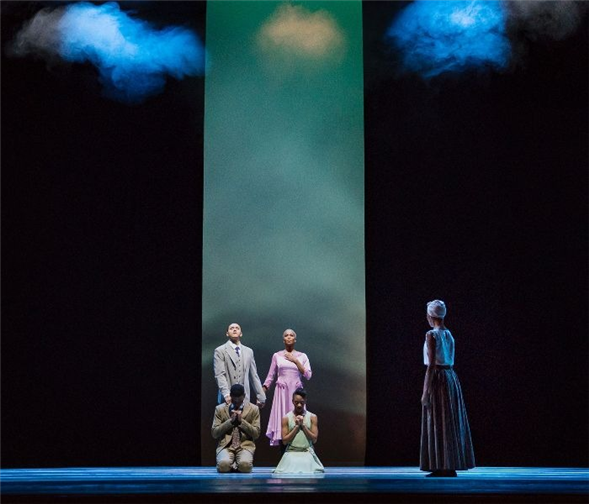Translate Page

Veteran choreographer Donald Byrd discusses his politically charged world premiere for Alvin Ailey
---
When Alvin Ailey American Dance Theater commissioned acclaimed choreographer Donald Byrd to create his fifth piece for the company, he knew immediately that he wanted to go back to the troupe's roots. "In the early days, the work was about the black experience in America," he explains. "I think we need to remember that."
His resulting world premiere, Greenwood, about the horrendous 1921 Tulsa race massacre, is a centerpiece of Ailey's month-long run at New York City Center, which kicks off December 4. Titled Ailey Revealed, the season features multiple works that explore aspects of the African-American experience, including Jamar Roberts' Ode, a tribute to victims of gun violence; a restaging of Camille A. Brown's City of Rain about struggling through the loss of a loved one; Darrell Grand Moultrie's Ounce of Faith, a jubilant toast to a teacher's lasting bond with a student; and Ailey's spiritual-infused masterwork Revelations, which Byrd saw as a young aspiring dancer and cites as life-altering.
With more than 100 searing ballets to his credit, Byrd, 70, is impressively prolific. He's created pieces for PHILADANCO!, Joffrey Ballet, Pacific Northwest Ballet and the Dance Theatre of Harlem, among others, and founded the now-defunct Donald Byrd/The Group, for which he crafted The Harlem Nutcracker. Since 2002, he's led Seattle's Spectrum Dance Theatre.
An unapologetic provocateur, Byrd has been known to make audiences uncomfortable with his unflinching pieces -- a previous commission for Ailey, Fin de Siècle, in which a dancer bared her anguished soul and body, was quickly dropped from the repertory. But Byrd believes that these days, there's "an enthusiastic embrace of acknowledging that things are fucked up and we don't get to pretend anymore."
With Greenwood, Byrd is shining a spotlight on a heinous piece of history that was deliberately downplayed for decades. The Greenwood District was a prosperous African-American community in Tulsa that was destroyed during the 1921 race massacre. A murky encounter between a young black man and a young white woman in an elevator elsewhere in the city sparked the violence, with angry white mobs descending on the neighborhood, burning buildings and attacking residents. In the end, 35 city blocks were destroyed, more than 800 people were treated for injuries and as many as 300 black residents were killed.
Byrd -- who earned a Tony nomination for choreographing the original Broadway production of The Color Purple and a Bessie Award for creating the The Minstrel Show -- understands the importance of narrative clarity in a dance like this. In rehearsals with the Ailey dancers, he explains that he cares less about physical virtuosity than creating kinetic conversations. His constant reminder is, "You don't have to be so strong all the time" as he pushes them to embrace a more nuanced approach.
"Gesture is really important in dance, especially if you're trying to tell a story," Byrd says. "People relate to and understand that if you reach out to someone, that movement is just an extension or amplification of the gesture. That's kind of a return to old values; it's broader and bigger and more theatrical."
In the piece, which is startlingly cinematic, Byrd juxtaposes the incident that set off the massacre against the story of a black family struggling to survive it. In the middle of the action, an "anti-Greek chorus" influences the events with militant precision. Byrd shows three different versions of what may have happened in that elevator; all lead to the same devastating violence.
Byrd's inspiration for Greenwood came while his company was performing in Tulsa seven years ago, when the producer invited him to visit the remnants of the neighborhood, which was never resurrected. Intrigued, Byrd started to do research, and came across mentions of "a race riot." However, "the more I read, the more I realized this was not a riot; it was a mass murder!" he says. "If anybody rioted it was the white people; the black people were just defending themselves."
Yet while the Tulsa race massacre was one of the worst outbreaks of racial violence in U.S. history, it isn't well-known. When the HBO series Watchmen debuted earlier this fall with an episode reenacting the atrocities, many viewers took to social media to say they were shocked they'd never learned about it in school. Greenwood gives New York City dance lovers a chance to meditate on what happened in a less graphic yet just as powerful way. Although it occurred almost a century ago, its legacy still reverberates. Byrd's work is a warning that in these polarized times, we can't let history repeat itself.
Greenwood will be performed as part of Ailey Revealed on December 6, 7, 8 20, 28, 31 and January 4.---
TDF MEMBERS: At press time, discount tickets were available for select Ailey Revealed dates. Go here to browse our current offers.
A dancer, teacher and playwright, Juan Michael Porter II has contributed articles to Ballet Review, The Dance Enthusiast, Time Out New York, Broadway World and HuffPost. Follow him at @juanmichaelii. Follow TDF at @ TDFNYC.
Top image: Alvin Ailey American Dance Theater in Donald Byrd's Greenwood. Photo by Paul Kolnik.